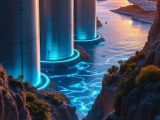
Blue Hydrogen: INPEX Unveils Japan’s First Integrated Blue Hydrogen and Ammonia Facility
November 25, 2025INPEX Corporation has pulled off a major coup by unveiling Japan’s first-ever integrated Blue Hydrogen and Blue Ammonia demo plant at Kashiwazaki Hydrogen Park in Niigata Prefecture. As the nation’s top upstream oil and gas player, INPEX isn’t just running experiments—they’re laser-focused on driving the Energy Transition. This isn’t a tabletop trial; it’s a full-scale, future-ready facility handling everything from natural gas reforming to CO₂ capture, underground storage, and low-carbon fuel production. By fusing hydrogen/ammonia synthesis with CCUS, INPEX is tossing old hurdles aside and setting a new benchmark for Asia.
Built for the Future: Site and History
You might ask, why Kashiwazaki? It sits atop the depleted Higashi-Kashiwazaki Gas Field, part of the Minami-Nagaoka gas system that’s powered Niigata’s industry since the 1970s. Kashiwazaki City—home to around 80,000 people—brings decades of energy know-how, ready-made pipelines, and rock-solid geology for CO₂ injection. Nestled on Honshu’s northwest coast, Niigata Prefecture has long juggled nuclear reactors, LNG terminals, and heavy manufacturing. Now it’s adding a low-carbon chapter, bolstering Japan Energy Security while charging toward its net-zero-by-2050 roadmap.
Secret Sauce: Integrated Technologies
At the heart of this setup are three powerhouse processes working hand in glove:
- Blue Hydrogen Production: Natural gas from Minami-Nagaoka gets cracked into hydrogen and CO₂. Thanks to advanced separation tech, over 90% of that CO₂ never sees the open air.
- CCUS: The captured CO₂ is compressed, whisked through short pipelines, and tucked deep into the porous layers of the old Higashi-Kashiwazaki reservoir—think of it as a permanent underground parking spot.
- Blue Ammonia Production: That clean hydrogen teams up with nitrogen from the air, then transforms into ammonia (NH₃), delivering a zero-carbon feedstock and flexible energy carrier for local industry.
And steering the show is HORIBA Ltd. Their precision instruments track gas compositions, liquid flows, and CO₂ purity in real time—keeping safety, efficiency, and environmental compliance on point.
Partnerships Driving Decarbonization
No pioneering project happens solo—it’s all about teamwork. NEDO (the New Energy and Industrial Technology Development Organization) brought crucial funding and tech coordination to boost Japan’s carbon-neutral push. JGC Japan Corporation handled the EPC side—designing and building everything from pipe racks to control rooms for the Blue Hydrogen and Blue Ammonia units. And, of course, HORIBA Ltd. keeps the analytics engines humming. It’s a perfect example of public and private sectors teaming up to fast-track the Energy Transition.
Real-World Impact
Here’s the real deal: this plant is set to churn out about 700 tonnes of combined Blue Hydrogen and Blue Ammonia each year. That hydrogen will plug into Niigata’s grid, slashing carbon in regional power generation, while the ammonia goes straight to local industries—from fertilizer producers to specialty chemical makers. And by capturing and storing over 90% of on-site CO₂, Kashiwazaki Hydrogen Park not only cuts greenhouse gas emissions but also strengthens Japan Energy Security by tapping domestic resources. Plus, it gives other Asian regions a blueprint for their own low-carbon journeys.
Challenges and the Road Ahead
No trailblazer’s path is without its bumps. Underground CO₂ storage can raise eyebrows, so honest community engagement and transparent monitoring are must-haves. Scaling up will call for creative financing—think fresh business models and possible policy incentives—to help Blue Hydrogen compete with grey or green alternatives. And we’ve got to keep a close eye on lifecycle emissions to ensure the “blue” tag really means net carbon wins. On the bright side, these learnings can inform smarter regulations, drive costs down through economies of scale, and kickstart the growth of hydrogen pipelines and ammonia logistics.
Bottom Line: Paving the Path to 2050
At the end of the day, Kashiwazaki Hydrogen Park is a massive leap on Japan’s quest for carbon neutrality. By seamlessly integrating Blue Hydrogen, Blue Ammonia, and CCUS in a working plant, it proves low-carbon energy chains aren’t just theory—they’re happening right now. With solid partnerships, cutting-edge tech, and a clear game plan, INPEX and its collaborators are sketching out a blueprint for sustainable energy that can roll out across Asia and beyond. And that’s something we can all celebrate.


 With over 15 years of reporting hydrogen news, we are your premier source for the latest updates and insights in hydrogen and renewable energy.
With over 15 years of reporting hydrogen news, we are your premier source for the latest updates and insights in hydrogen and renewable energy.